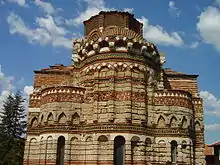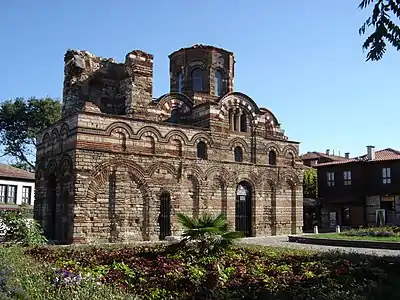| Church of Christ Pantocrator Църква "Христос Пантократор" | |
|---|---|
 South view of the Church of Christ Pantocrator | |
| Religion | |
| Affiliation | Eastern Orthodox |
| Location | |
| Location | Nesebar, Bulgaria |
| Geographic coordinates | 42°39′31″N 27°44′0″E / 42.65861°N 27.73333°E |
| Architecture | |
| Type | Church |
| Completed | 13th-14th century |


The Church of Christ Pantocrator (Bulgarian: църква „Христос Пантократор“, tsarkva „Hristos Pantokrator“ or църква „Христос Вседържател“, tsarkva „Hristos Vsedarzhatel“, Byzantine Greek: Ναός Χριστού Παντοκράτωρος) is a medieval Eastern Orthodox church in the eastern Bulgarian town of Nesebar (medieval Mesembria), on the Black Sea coast of Burgas Province. Part of the Ancient Nesebar UNESCO World Heritage Site, the Church of Christ Pantocrator was constructed in the 13th–14th century and is best known for its lavish exterior decoration. The church, today an art gallery, survives largely intact and is among Bulgaria's best preserved churches of the Middle Ages.[1]
History
The Church of Christ Pantocrator is usually dated to the late 13th or early 14th century.[2][3] University of Pennsylvania scholar Robert G. Ousterhout places its construction in the mid-14th century.[4] Rough Guides author Jonathan Bousfield attributes its building to the rule of Tsar Ivan Alexander of Bulgaria (r. 1331–1371),[5] though during this time control of Nesebar changed many times between the Second Bulgarian Empire and Byzantium.[6] The church is dedicated to Christ Pantocrator, a name of God which hails him as the "Ruler of All" in Greek.[3][7]
The church is located on Mesembria Street,[5] near the entrance to Nesebar's old town.[1] Nowadays, it houses an art gallery which exhibits works by Bulgarian artists.[5] As it belongs to the old town of Nesebar, the Church of Christ Pantocrator forms part of the Ancient City of Nesebar UNESCO World Heritage Site[8] and the 100 Tourist Sites of Bulgaria.[9] Since 1927, it has been under state protection as a "national antiquity", and it was listed among Bulgaria's monuments of culture of national importance in 1964.[10]
Architecture
The church is designed in late Byzantine cross-in-square style.[7][11] It was constructed from stones and brickwork, a construction technique known as opus mixtum,[12] and measures 16 by 6.90 metres (52.5 ft × 22.6 ft),[3][12] 16 by 6.70 metres (52.5 ft × 22.0 ft), or 14.20 by 4.80 metres (46.6 ft × 15.7 ft), depending on the source.[2] The walls of the church are 0.80 metres (2.6 ft) thick.[13] The colour of the bricks gives the church a ruddy appearance.[5]
The church features a narthex and a cella (or "naos") with an essentially rectangular elongated plan.[7] The narthex is small, but has a medieval tomb underneath it. There are four entrances to the church: two accessing the cella from the south and west, and another two for the narthex from the west and north. The apse of the church has three small parts which overlap each other to form a single, larger unit. The prothesis and diaconicon of the church are located by the apse.[2][3]
The dome, octagonal in shape, stands prominently on top of the centre of the cella. It was supported by four now-destroyed columns which were located directly beneath it. The integrated bell tower has been built on top of the narthex, as was customary in contemporary Byzantine church architecture, and extends from the rectangular main structure.[12][14] The bell tower was originally rectangular, though it is now partially ruined. It was reached from the south by means of a stone staircase.[2][3]
Decoration

The best-known feature of the Church of Christ Pantocrator is the rich and colourful decoration of its exterior walls.[5] The most lavishly decorated part of the church is the east side with the apse, and as a whole all sides of the church exhibit different ornamentation. Interchanging strips of three or four rows of bricks and carved stones, which create an optical pattern, are the most basic type of decoration used.[13] Rows of blind arches, four-leaved floral motifs, triangular ornaments, circular turquoise ceramics and brick swastika friezes run along the east wall.[2] Ousterhout likens the appearance of the church's superimposed arcades to an aqueduct;[4][12] an earlier example of that configuration can be observed in the Cappadocian church of Çanlı Kilise near Aksaray, Turkey.[15] The inclusion of swastikas in the decoration is considered unusual and curious to tourists.[1][5] It is explained by the medieval use of the swastika as a symbol of the Sun.[3]
The decoration of the elongated north and south walls includes brick blind arches in the bottom part and a large arch for each wall adjacent to the dome with a columned window in the middle.[2] There are windows above the lower arches of the north and south facade. The dome, which also exhibits a large number of ornamental details and ceramics, features eight windows, one for each of its sides. The medieval frescoes which were painted on the interior walls of the church have been only fragmentarily preserved.[3]
References
- 1 2 3 Kay, Annie (2008). Bulgaria: The Bradt Travel Guide. Bradt Travel Guides. p. 265. ISBN 978-1-84162-155-5.
- 1 2 3 4 5 6 Николова, Бистра (2002). Православните църкви през Българското средновековие IX–XIV в. [The Orthodox churches during the Bulgarian Middle Ages 9th–14th century] (in Bulgarian). София: Академично издателство "Марин Дринов". pp. 147–148. ISBN 954-430-762-1.
- 1 2 3 4 5 6 7 "The Christ Pantocrator Church". Museum Ancient Nessebar. Archived from the original on 19 July 2011. Retrieved 25 November 2010.
- 1 2 Ousterhout, Robert G. (2008). Master builders of Byzantium. UPenn Museum of Archaeology. p. 207. ISBN 978-1-934536-03-2.
- 1 2 3 4 5 6 Bousfield, Jonathan; Richardson, Dan (2002). Rough guide to Bulgaria (4th ed.). Rough Guides. pp. 398–399. ISBN 978-1-85828-882-6.
- ↑ Kazhdan, Alexander (1991). "Mesembria". Oxford Dictionary of Byzantium. Oxford University Press. pp. 1347–1348. ISBN 978-0-19-504652-6.
- 1 2 3 ""ПАНТОКРАТОР" ("Вседържител")" ["PANTOCRATOR" ("Ruler of All")]. Българска енциклопедия А–Я [Bulgarian Encyclopedia A–Ya] (CD) (in Bulgarian). БАН, Труд, Сирма. 2002. ISBN 954-8104-08-3.
- ↑ "Ancient City of Nessebar". UNESCO World Heritage Centre. Archived from the original on 8 February 2011. Retrieved 25 November 2010.
- ↑ "6. Архитектурно-исторически резерват — археологически музей" [6. Architectural and historical reserve — archaeological museum] (in Bulgarian). Български туристически съюз. Archived from the original on 8 August 2010. Retrieved 25 November 2010.
- ↑ "Списък на паметниците на културата с категория "Национално значение" на територията на Област Бургас /по населени места/" [List of monuments of culture with the category "national importance" on the territory of Burgas Province by populated places] (PDF) (in Bulgarian). Министерство на културата на Република България. p. 5. Archived from the original (PDF) on 9 April 2011. Retrieved 1 November 2010.
- ↑ Fletcher, Banister; Cruickshank, Dan (1996). Sir Banister Fletcher's a history of architecture (20th ed.). Architectural Press. p. 322. ISBN 978-0-7506-2267-7.
- 1 2 3 4 "Mesembria (Middle Ages), Μonuments". Encyclopaedia of the Hellenic World. 2008. Archived from the original on 9 October 2011. Retrieved 25 November 2010.
- 1 2 Partov, Doncho N.; Christo T. Christov; Vesselin K. Kantchev; Dobromir E. Dinev; Aleksander K. Taushanov; Edelvais E. Popova; Deian P. Mitev. "State of Art of Historic Structures in Bulgaria" (PDF). ARCCHIP Advanced Research Centre for Cultural Heritage Interdisciplinary Projects. p. 4. Archived from the original (PDF) on 18 July 2011. Retrieved 25 November 2010.
- ↑ Ousterhout, Robert G. (1987). The architecture of the Kariye Camii in Istanbul. Dumbarton Oaks. p. 109. ISBN 978-0-88402-165-0.
- ↑ Ousterhout, Robert G. (2006). A Byzantine settlement in Cappadocia. Dumbarton Oaks. p. 71. ISBN 978-0-88402-310-4.
